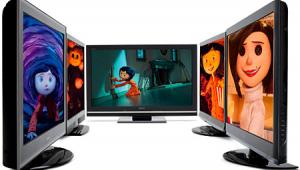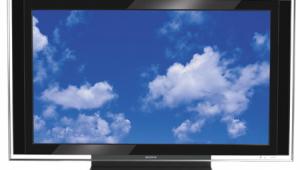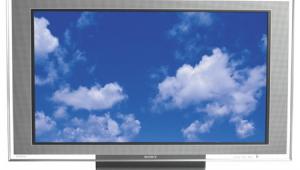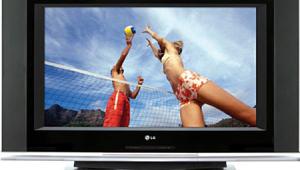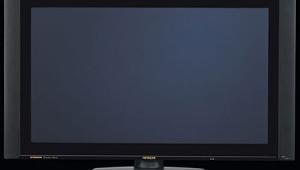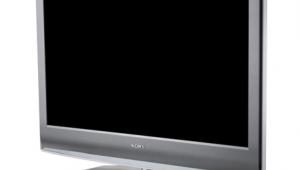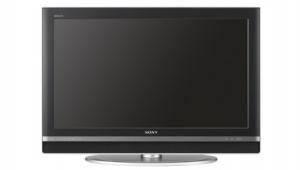Panasonic TH-50PHW3 & Pioneer PDP-5030HD
That first 50-inch Pioneer plasma—the first on the market capable of displaying high-definition images—cost $25,000. This new, third-generation product, greatly improved and with many additional features, lists for $15,500—a 40% drop. I had never reviewed a Panasonic plasma before, but I remember seeing engineers working on a prototype when I visited the company's labs in New Jersey in 1997.
Retailers report that plasmas are now their hottest-selling items, some selling for as little as $3000 or $4000—still quite expensive, but no longer stratospheric. The two models reviewed here are among the top of the line among plasmas, and the Panasonic costs $12,999—about half the price of that early Pioneer.
Because the Pioneer and the Panasonic were delivered at roughly the same time, we decided to combine them in a single review. But they're different in one important respect: Like almost every other plasma on the market, the Panasonic is a monitor only; it is intended to be used with external components. The Pioneer offers as standard equipment some important features that the Panasonic doesn't. For its $15,500 price, it comes with an outboard receiver box that is a cable-ready NTSC tuner. The latter attaches to the plasma with two proprietary cables. With that box, Pioneer is also able to provide a complete array of connections on the back of the receiver, including three S-video, five composite, two component, and one RGB. Both sets require an external digital tuner to receive HDTV.
Significantly, the Pioneer has no cooling fan. But plasma panels require a lot of power, and power means heat. To avoid having to include a fan, designers must be resourceful in trading off the need for a robust power supply and the domestic benefits of fan-free—and thus noise-free—operation. In that, it's notable how well Pioneer has succeeded in the PDP-5030HD.
Both displays have a 16:9 aspect ratio and measure 50 inches diagonally. Both are capable of displaying high-definition: 720p at full resolution, 1080i at reduced resolution. The Panasonic has slightly higher resolution: 1366X768 pixels vs. the Pioneer's 1280X768. The difference in horizontal resolution should be barely visible.
Both have 3:2 pulldown correction for cleaning up artifacts in film-based programming, both have the best digital comb filter for composite inputs, and both are just under 4 inches thick and weigh just under 100 lbs. (The Panasonic's convenient rear handles make it possible for one person to lift and carry it short distances.)
The Panasonic, limited by the lack of real estate on its rear panel, offers only a bare assortment of connectors—one each of every type. For those who use it as part of a larger home-theater system, this won't matter; their A/V receivers or processors should offer all the jacks they'll need. But those who want to use the Pioneer on its own will find that it comes with two speakers that bolt to the left and right edges of the display. The audio controls are reachable through onscreen menus, and the sound quality was about equal to the sound from the speakers built into most TVs. (For the $2500 difference in price between the Panasonic and the Pioneer, one could buy a VCR to serve as an NTSC tuner and a far better sound system.) The Panasonic comes with a basic black remote appropriate for a monitor (i.e., no channel or volume-control buttons). It is not backlit. The Pioneer comes with a large, silver, full-featured, programmable remote that is fully backlit, but a bit confusing in places. At one spot, three buttons next to each other in a line are labeled Menu. Only by looking closely can you see that they're intended to call up menus on different devices the remote might control.
Panasonic TH-50PHW3
I had both displays in-house at the same time for a brief period, but the Panasonic TH-50PHW3 arrived first, and I spent a couple of weeks with it before the Pioneer arrived. I could not have been more impressed. The picture was super-bright and sharp as a knife.
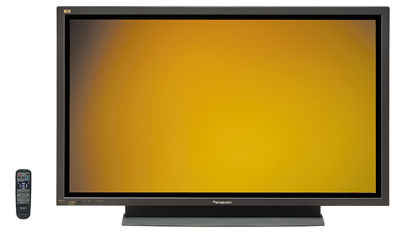
The frequency-sweep resolution test patterns on the Video Essentials test DVD were well-delineated almost all the way to the finest detail. When I ran through the disc's video sequences, the scenes intended to demonstrate video noise were especially clean, if not perfect—some artifacts were visible. But overall, the Panasonic's scaler, which converts all 480i images to the panel's native resolution, worked surprisingly well. When I switched my Sony DVD player to progressive output, there was no particular advantage; the signal was not appreciably better than the picture produced by the set's internal scaler from an interlaced source.
Many plasmas suffer from excessive video noise that's especially visible on dark test patterns. Not the TH-50PHW3—its picture was stable and still. Some plasmas also suffer from what I call solarization, or the smearing of solid dark areas. A woman's dark hair, for example, might show as a solid dark blob. I saw none of this on the Panasonic.
Historically, plasmas have had a difficult time displaying true black. More recently, top-of-the-line plasmas like the Panasonic have been able to display black but unable to delineate patterns or details within those black areas. That was true of the Panasonic. It could show deep black, but details in dark areas were lost. I watched parts of several movies and was never disappointed until I put The Plasma Slayer in my DVD player: Dark City, so named because, until the very end, the film takes place entirely at night. Dark building walls in this movie portrayed on a good CRT monitor show subtle brick patterns. On the Panasonic, the walls were simply sheets of black. This was not a failure of this model but a weakness of the plasma technology itself. Every plasma display I've seen has had this fault.
I watched some HDTV: a concert and several sporting events on HDNet, DirecTV's all-high-definition channel. The picture was radiant, sharp, fully detailed. The Panasonic crossed that almost magical threshold—watching high-definition images on it was like looking out a window, though occasionally the unit had trouble with fast action sequences, as do all plasmas. In those cases, there was some smearing.
I had no complaints about the Panasonic. Its price is as low as I've seen, and its performance was magnificent. A winner.
